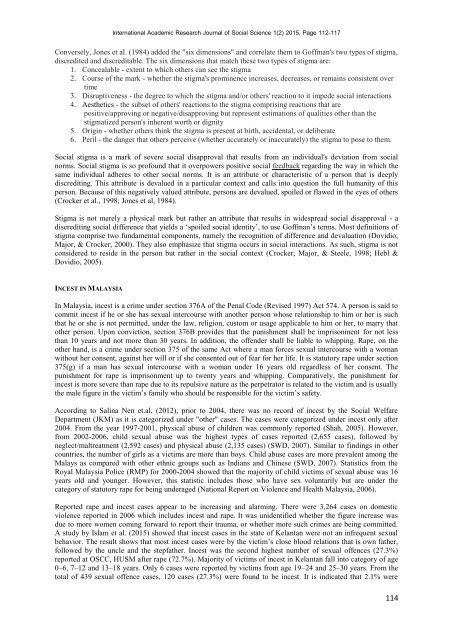Social Stigma of Incest in Malaysia
17-P112-117
17-P112-117
You also want an ePaper? Increase the reach of your titles
YUMPU automatically turns print PDFs into web optimized ePapers that Google loves.
International Academic Research Journal <strong>of</strong> <strong>Social</strong> Science 1(2) 2015, Page 112-117<br />
Conversely, Jones et al. (1984) added the "six dimensions" and correlate them to G<strong>of</strong>fman's two types <strong>of</strong> stigma,<br />
discredited and discreditable. The six dimensions that match these two types <strong>of</strong> stigma are:<br />
1. Concealable - extent to which others can see the stigma<br />
2. Course <strong>of</strong> the mark - whether the stigma's prom<strong>in</strong>ence <strong>in</strong>creases, decreases, or rema<strong>in</strong>s consistent over<br />
time<br />
3. Disruptiveness - the degree to which the stigma and/or others' reaction to it impede social <strong>in</strong>teractions<br />
4. Aesthetics - the subset <strong>of</strong> others' reactions to the stigma compris<strong>in</strong>g reactions that are<br />
positive/approv<strong>in</strong>g or negative/disapprov<strong>in</strong>g but represent estimations <strong>of</strong> qualities other than the<br />
stigmatized person's <strong>in</strong>herent worth or dignity<br />
5. Orig<strong>in</strong> - whether others th<strong>in</strong>k the stigma is present at birth, accidental, or deliberate<br />
6. Peril - the danger that others perceive (whether accurately or <strong>in</strong>accurately) the stigma to pose to them.<br />
<strong>Social</strong> stigma is a mark <strong>of</strong> severe social disapproval that results from an <strong>in</strong>dividual's deviation from social<br />
norms. <strong>Social</strong> stigma is so pr<strong>of</strong>ound that it overpowers positive social feedback regard<strong>in</strong>g the way <strong>in</strong> which the<br />
same <strong>in</strong>dividual adheres to other social norms. It is an attribute or characteristic <strong>of</strong> a person that is deeply<br />
discredit<strong>in</strong>g. This attribute is devalued <strong>in</strong> a particular context and calls <strong>in</strong>to question the full humanity <strong>of</strong> this<br />
person. Because <strong>of</strong> this negatively valued attribute, persons are devalued, spoiled or flawed <strong>in</strong> the eyes <strong>of</strong> others<br />
(Crocker et al., 1998; Jones et al, 1984).<br />
<strong>Stigma</strong> is not merely a physical mark but rather an attribute that results <strong>in</strong> widespread social disapproval - a<br />
discredit<strong>in</strong>g social difference that yields a ‘spoiled social identity’, to use G<strong>of</strong>fman’s terms. Most def<strong>in</strong>itions <strong>of</strong><br />
stigma comprise two fundamental components, namely the recognition <strong>of</strong> difference and devaluation (Dovidio,<br />
Major, & Crocker, 2000). They also emphasize that stigma occurs <strong>in</strong> social <strong>in</strong>teractions. As such, stigma is not<br />
considered to reside <strong>in</strong> the person but rather <strong>in</strong> the social context (Crocker, Major, & Steele, 1998; Hebl &<br />
Dovidio, 2005).<br />
INCEST IN MALAYSIA<br />
In <strong>Malaysia</strong>, <strong>in</strong>cest is a crime under section 376A <strong>of</strong> the Penal Code (Revised 1997) Act 574. A person is said to<br />
commit <strong>in</strong>cest if he or she has sexual <strong>in</strong>tercourse with another person whose relationship to him or her is such<br />
that he or she is not permitted, under the law, religion, custom or usage applicable to him or her, to marry that<br />
other person. Upon conviction, section 376B provides that the punishment shall be imprisonment for not less<br />
than 10 years and not more than 30 years. In addition, the <strong>of</strong>fender shall be liable to whipp<strong>in</strong>g. Rape, on the<br />
other hand, is a crime under section 375 <strong>of</strong> the same Act where a man forces sexual <strong>in</strong>tercourse with a woman<br />
without her consent, aga<strong>in</strong>st her will or if she consented out <strong>of</strong> fear for her life. It is statutory rape under section<br />
375(g) if a man has sexual <strong>in</strong>tercourse with a woman under 16 years old regardless <strong>of</strong> her consent. The<br />
punishment for rape is imprisonment up to twenty years and whipp<strong>in</strong>g. Comparatively, the punishment for<br />
<strong>in</strong>cest is more severe than rape due to its repulsive nature as the perpetrator is related to the victim and is usually<br />
the male figure <strong>in</strong> the victim’s family who should be responsible for the victim’s safety.<br />
Accord<strong>in</strong>g to Sal<strong>in</strong>a Nen et.al, (2012), prior to 2004, there was no record <strong>of</strong> <strong>in</strong>cest by the <strong>Social</strong> Welfare<br />
Department (JKM) as it is categorized under "other" cases. The cases were categorized under <strong>in</strong>cest only after<br />
2004. From the year 1997-2001, physical abuse <strong>of</strong> children was commonly reported (Shah, 2005). However,<br />
from 2002-2006, child sexual abuse was the highest types <strong>of</strong> cases reported (2,655 cases), followed by<br />
neglect/maltreatment (2,592 cases) and physical abuse (2,135 cases) (SWD, 2007). Similar to f<strong>in</strong>d<strong>in</strong>gs <strong>in</strong> other<br />
countries, the number <strong>of</strong> girls as a victims are more than boys. Child abuse cases are more prevalent among the<br />
Malays as compared with other ethnic groups such as Indians and Ch<strong>in</strong>ese (SWD, 2007). Statistics from the<br />
Royal <strong>Malaysia</strong> Police (RMP) for 2000-2004 showed that the majority <strong>of</strong> child victims <strong>of</strong> sexual abuse was 16<br />
years old and younger. However, this statistic <strong>in</strong>cludes those who have sex voluntarily but are under the<br />
category <strong>of</strong> statutory rape for be<strong>in</strong>g underaged (National Report on Violence and Health <strong>Malaysia</strong>, 2006).<br />
Reported rape and <strong>in</strong>cest cases appear to be <strong>in</strong>creas<strong>in</strong>g and alarm<strong>in</strong>g. There were 3,264 cases on domestic<br />
violence reported <strong>in</strong> 2006 which <strong>in</strong>cludes <strong>in</strong>cest and rape. It was unidentified whether the figure <strong>in</strong>crease was<br />
due to more women com<strong>in</strong>g forward to report their trauma, or whether more such crimes are be<strong>in</strong>g committed.<br />
A study by Islam et al. (2015) showed that <strong>in</strong>cest cases <strong>in</strong> the state <strong>of</strong> Kelantan were not an <strong>in</strong>frequent sexual<br />
behavior. The result shows that most <strong>in</strong>cest cases were by the victim’s close blood relations that is own father,<br />
followed by the uncle and the stepfather. <strong>Incest</strong> was the second highest number <strong>of</strong> sexual <strong>of</strong>fences (27.3%)<br />
reported at OSCC, HUSM after rape (72.7%). Majority <strong>of</strong> victims <strong>of</strong> <strong>in</strong>cest <strong>in</strong> Kelantan fall <strong>in</strong>to category <strong>of</strong> age<br />
0–6, 7–12 and 13–18 years. Only 6 cases were reported by victims from age 19–24 and 25–30 years. From the<br />
total <strong>of</strong> 439 sexual <strong>of</strong>fence cases, 120 cases (27.3%) were found to be <strong>in</strong>cest. It is <strong>in</strong>dicated that 2.1% were<br />
114


